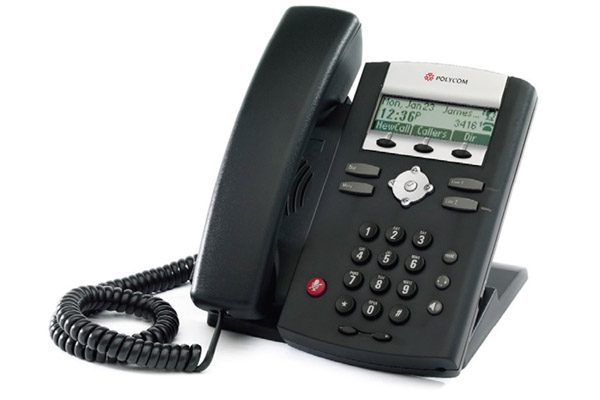Polycom SoundPoint IP 330 review
VoIP phones could bring significant cost savings and flexibility to your business. We take a look at one of the latest enterprise calls SIP handsets from Polycom.

But is this phone the one to choose for your company's big push into VOIP? Well it certainly ticks all the boxes in terms of its core abilities. It's robust, well, made and easy to use, so most users should be able to take full advantage of its advanced capabilities without recourse to a manual or instruction sheet.Sound quality is superb too, both in standard and speakerphone mode, and it boasts a number of genuinely useful features. We'd perhaps have liked to see support for more SIP accounts for the ultimate in flexibility, and the price is a little on the high side, but other than that there's very little to complain about. The PolyCom SoundPoint IP 330 is a top quality bit of kit.
FeaturesFeatures-wise there's also a lot to like about this piece of hardware too. There's twin line support, so you can set the phone up with more than one SIP provider if you wish (though it's not quite as impressive as the excellent SNOM M3 handset, which let you run eight simultaneously).If you take a look at the rear of the 330, you'll see another thoughtful touch - a pair of network ports. This is useful on two counts: first, you don't need to provide an extra network socket for PC users and second, you save on cabling and mess with the PC connection only having to plug into the rear of the phone rather than reach to a pillar or floorbox.Not only that, but the 330 also supports PoE (power over Ethernet), so you don't need to find an extra power point to plug the phone into either. Codec support runs to the standard, uncompressed G.711, with the lower quality G.729A provided for situations where bandwidth is a problem. Finally, if you're coupling the phone with a fully-featured VoIP platform or service, it's a no-brainer to set up. Our test unit came provisioned for a COMS www.coms.com hosted VOIP platform and we found we just needed to plug it in, choose the setup option and wait a minute or so for it to set up for our network. Any administration on the phone, should you need to do it, can be carried out using the phone's embedded http server. The thought of being able to do this for a whole office, from small to large, with all of the flexibility that a hosted telephony system such as this provides - is enough to convince us that VOIP is the way to go.
Those benefits include the ability to change location and retain numbers at the drop of a hat, and to add site offices and teleworker locations without complex setup procedures and all without the sort of large initial investment or engineering support on the ground required by traditional PBX-based systems.
Verdict
But is this phone the one to choose for your company's big push into VOIP? Well it certainly ticks all the boxes in terms of its core abilities. It's robust, well, made and easy to use, so most users should be able to take full advantage of its advanced capabilities without recourse to a manual or instruction sheet. Sound quality is superb too, both in standard and speakerphone mode, and it boasts a number of genuinely useful features. We'd perhaps have liked to see support for more SIP accounts for the ultimate in flexibility, and the price is a little on the high side, but other than that there's very little to complain about. The PolyCom SoundPoint IP 330 is a top quality bit of kit.
Display: LCD 102 x 33 pixels GUI Audio features: Hands-free Full-duplex, voice activity detection, Individual visual volume settings, comfort noise fill, acoustic echo cancellation Frequency response: 300Hz-3300Hz Coec support: G.711 u/A and G.729A (Annex B) networks connectivity: IEEE 802.3af PoE, dual-port Ethernet, DHCP compatibility, QoS, NAT support Compatibility: Microsoft LCD 2005 Security: Transport Layer Security (TLS), IEEE 802.1p/Q tagging (VLAN), Layer 3 TOS, and DSCP
Get the ITPro daily newsletter
Sign up today and you will receive a free copy of our Future Focus 2025 report - the leading guidance on AI, cybersecurity and other IT challenges as per 700+ senior executives
-
 Westcon-Comstor and Vectra AI launch brace of new channel initiatives
Westcon-Comstor and Vectra AI launch brace of new channel initiativesNews Westcon-Comstor and Vectra AI have announced the launch of two new channel growth initiatives focused on the managed security service provider (MSSP) space and AWS Marketplace.
By Daniel Todd Published
-
 Third time lucky? Microsoft finally begins roll-out of controversial Recall feature
Third time lucky? Microsoft finally begins roll-out of controversial Recall featureNews The Windows Recall feature has been plagued by setbacks and backlash from security professionals
By Emma Woollacott Published
-
 The UK government wants quantum technology out of the lab and in the hands of enterprises
The UK government wants quantum technology out of the lab and in the hands of enterprisesNews The UK government has unveiled plans to invest £121 million in quantum computing projects in an effort to drive real-world applications and adoption rates.
By Emma Woollacott Published